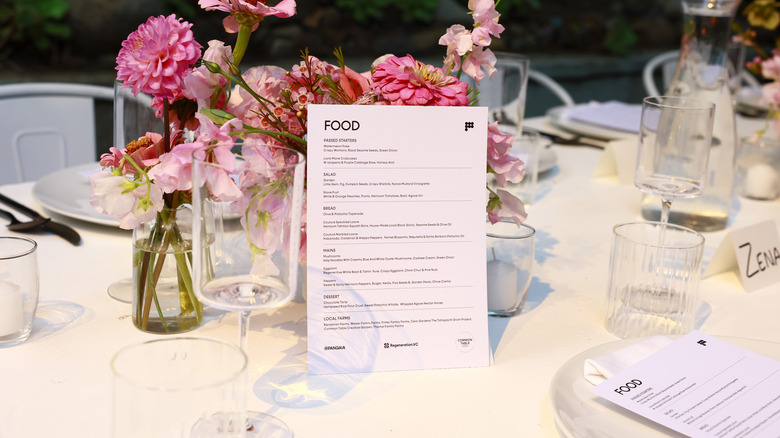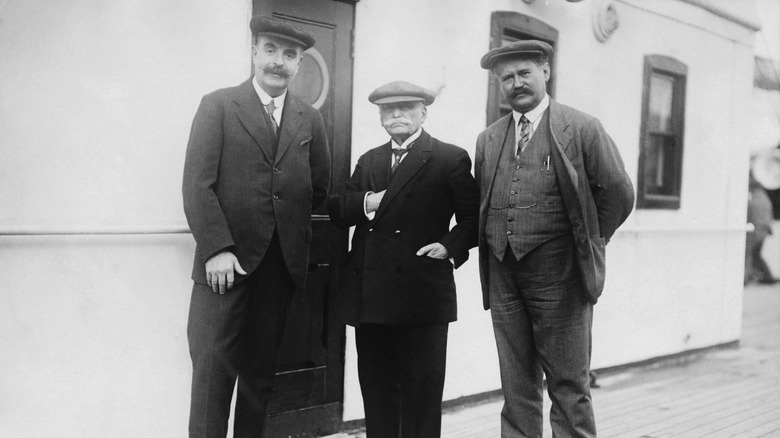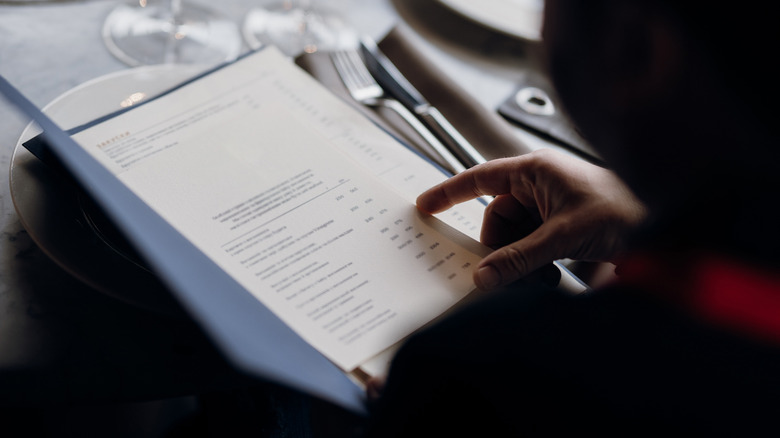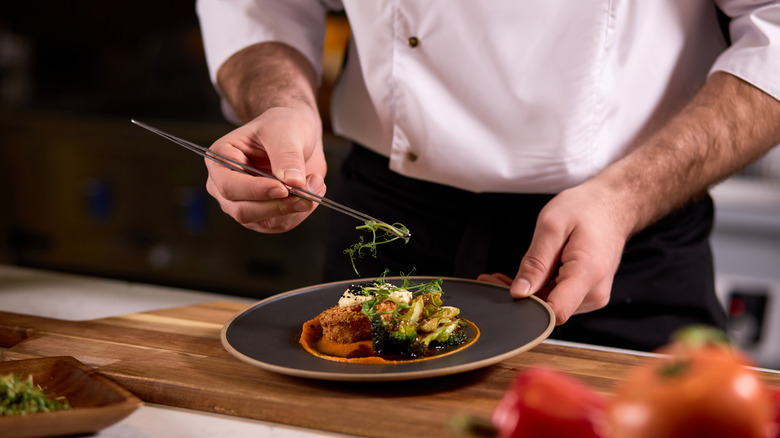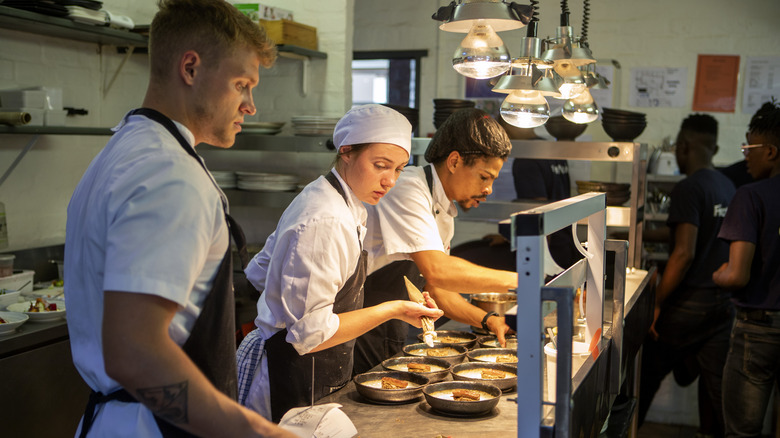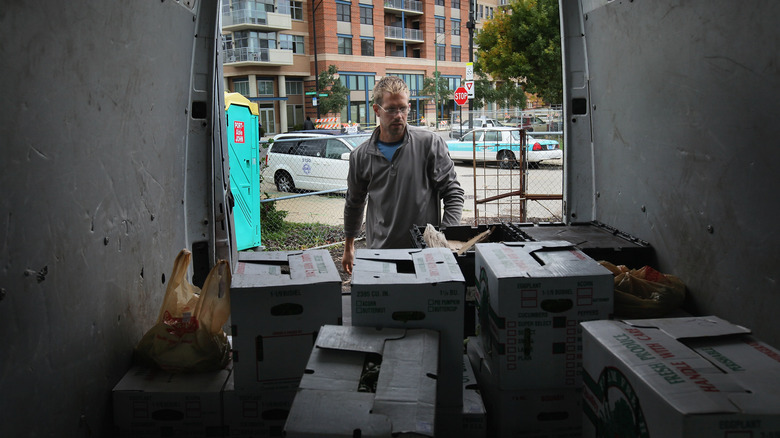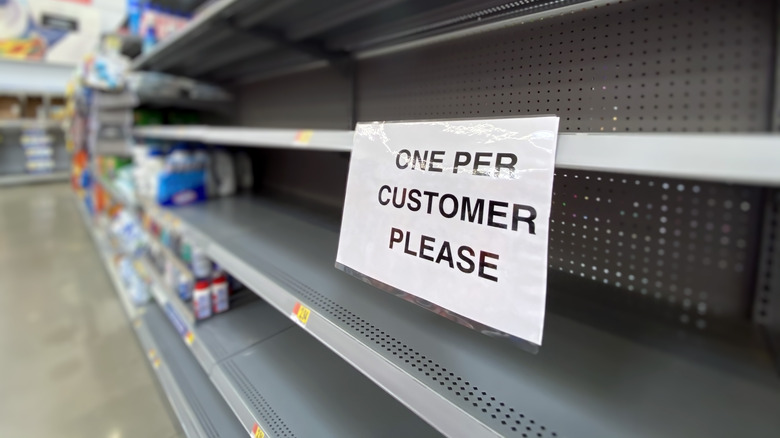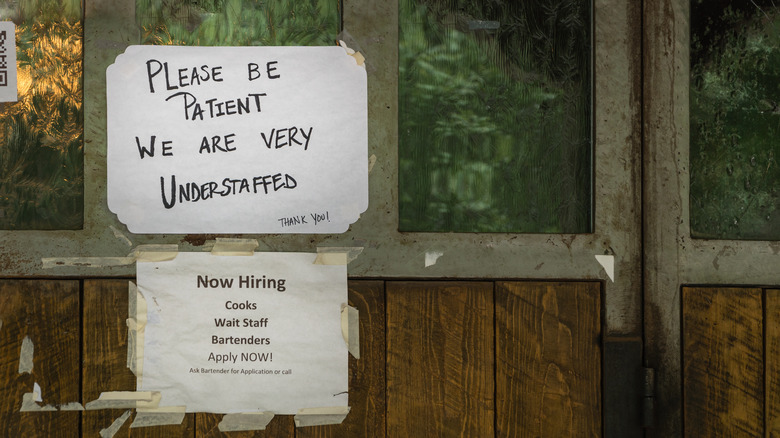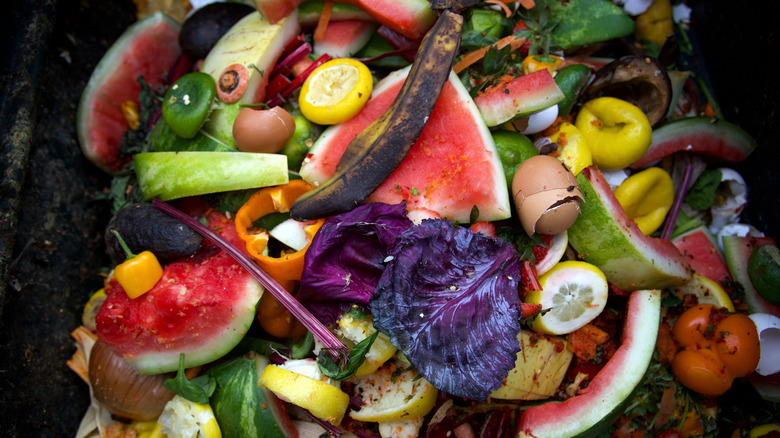Facts You Should Know About Prix Fixe Menus
The importance of menus cannot be overstated. They are, as The Guardian explains, marketing tools that not only exhibit what a restaurant has to offer but also guide consumers towards the most expensive options available. Yet, it would be a mistake to treat all menus similarly, as there are numerous types found throughout the culinary world. For instance, à la carte menus have wide-ranging options, while a tasting menu features carefully curated meals with limited options.
In between these two extremes lies the prix fixe menu. This type of menu typically offers diners a two- or three-course meal and gives them the ability to choose from a small number of options per course. There is a set price that is applied regardless of the combination of dishes they select (via Ueat).
According to Thrillist, prix fixe menus — which are also known as fixed or set menus — have become increasingly popular in recent years, especially since the coronavirus pandemic thrust the restaurant world into a state of disarray. While COVID-19 may have been responsible for the prix fixe menu's renaissance, its continued popularity is due to a host of reasons.
Prix fixe menus were invented by Auguste Escoffier
Auguste Escoffier was responsible for transforming professional cooking during the late 19th and early 20th centuries, per The New European. During this time, Escoffier made many contributions to gastronomy that are still felt today. These include introducing the brigade de cuisine hierarchical system for large professional kitchens, standardizing the idea of restaurants cooking to order, and creating the prix fixe menu.
The invention of the latter was predominantly born out of frustration when Escoffier was cooking at the Grand Hotel in Monte Carlo. The clientele that frequented this establishment was, according to History Today, wealthy, yet uneducated when it came to the complex and nuanced world of French haute cuisine.
Escoffier decided to curate the dining experience and minimize the choices for his inexperienced customers. By doing this, he ensured that they avoided the embarrassment of not understanding the menu, ordering poorly, or panicking and ordering the same old dishes.
When he moved to London to work at The Savoy in 1890, Escoffier brought the prix fixe menu with him. This helped cement its popularity among the British upper classes and internationally.
They are the middle ground between a la carte and tasting menus
The à la carte menu allows diners to order individual dishes. This type of menu has become the most popular in restaurants. This is generally thought to be because, as Forbes reported, customers want variation and control over their dining experiences.
On the other end of the dining spectrum is the highly prestigious tasting menu. This menu type is set with specific dishes being served at regular intervals to all who are eating (via Restaurant Clicks). Since the 90s, the tasting menu has become synonymous with fine dining establishments and has frequently been touted as the pinnacle of gastronomic innovation and skill, per Vanity Fair. However, in recent years the sheen has been rubbing off the tasting menu as the portions have shrunk and prices have increased, as reported by Club Oenologique.
In comparison, the prix fixe menu offers the best of both worlds; chefs are empowered to dictate how, and what, diners should eat, while customers are also allowed some freedom of choice. This fact is highlighted by Jeff Stone, CEO of Compeat, in an interview with FSR magazine. "...modern diners need to feel somewhat in control of their order," he explained. "Whether due to food allergies or preference, one size does not fit all in dining so there needs to be some wiggle room for guests to be fully satisfied with a set menu."
Staff members find prix fixe menus less stressful
Working in a restaurant can be extremely stressful for all staff members. In fact, the Royal Society for Public Health found that 84% of hospitality workers experienced stress related to their job, with nearly a quarter seeking psychological support or medication as a result. Reducing workplace stress has become even more important for hospitality employers as owners battle to keep staff amid one of the industry's worst labor shortages ever, per The Economist.
Replacing à la carte menus with prix fixe menus has the potential to reduce workplace stress for employees. This is because having a smaller menu reduces the number of tasks that need to be performed by kitchen staff, as explained by Jeremiah Langhorne, chef and co-owner of a restaurant in Washington D.C. "In an à la carte version or even the version we have right now, where there could be four or five different protein courses that are being cooked over the hearth, the workload's heavier; the stress is heavier," he explained. "[By having a prix fixe menu] We're just giving ourselves the opportunity to really nail things down as best we can and give our staff a level of consistency that allows them to focus on their craft as well," (via InsideHook).
Prix fixe menus transform a meal into an experience
While those in the service industry are frequently reminded that the customer is always right, diners' orders can often leave chefs frustrated. This is frequently because they feel these choices do not allow them to demonstrate their abilities as a chef or highlight the key facets of the restaurant, per Hospitality Magazine.
However, prix fixe menus hand control back to the chefs, allowing them to fully express themselves and represent the restaurant as they see fit, as explained by Chef Clinton McIver. "The set menu allows us to articulate the food we want to do and the experience we want the guest to have," he noted. "It gives us greater control of our kitchen and preparation and we can represent ourselves accurately."
Not only does relinquishing control over a meal give chefs the ability to express themselves, but it can also transform the diner's experience into one that is both surprising and exciting. This is because, as Thrillist explains, diners are more likely to be pushed out of their comfort zone, eating foods they wouldn't normally order.
Having limited choices boosts customer satisfaction
Balancing the number of choices available to diners is a difficult task. Too much choice, explains The Guardian, and consumers are paralyzed by a phenomenon known as the paradox of choice. After they have made a selection, many diners fear they may have missed out on something potentially better. This leads to a disappointing overall experience (via CBC). This disappointing experience is all too common in the modern-day setting where numerous choices are on offer, such as at retail stores, per Harvard Business Review.
As we have already seen, eliminating this choice can have the opposite effect. According to Vanity Fair, when customers have no autonomy over an experience they can feel constrained, and as though they are merely cogs in a wider machine. As reported by Hospitality Net, prix fixe menus offer a limited degree of choice that allows customers to make their own decisions regarding foods without exposing them to the debilitating paradox of choice.
They are cheaper for both the restaurant and its guests
A key attraction of a prix fixe menu for both the restaurant and customer is its price point. From a restaurant's perspective, prix fixe menus are usually cheaper to produce than à la carte menus. This is because fewer items on the menu mean there are fewer tasks to perform. Thus, employees work fewer hours, so the restaurant saves money on labor, per Robb Report.
In addition to this, restaurants can also streamline their produce orders and benefit from bulk ordering (via TouchBistro). Restaurants also benefit by knowing exactly how much money each table will spend. This differs from à la carte menus where, as Chef Joey Ward points out to Thrillist, you have no guarantee that a table will order anything more than an appetizer.
More often than not, these savings are handed on to the public, with prix fixe menus being considerably cheaper than à la carte alternatives. As highlighted by food critic Jay Rayner for The Guardian, the cost of set menus can be half that of à la carte. Furthermore, customers come to the meal knowing exactly how much it is going to cost, which saves them any unwanted surprises when the check arrives (via Wix).
Supply chain issues have prompted the format's comeback
The coronavirus pandemic not only crippled the hospitality industry but also revealed how vulnerable national and international supply chains are (via the U.S. Department of Agriculture). According to Forbes, many restaurants struggled — and still struggle — to have a constant and reliable source of many items, including kitchen equipment, takeout paraphernalia, and ingredients.
While prix fixe menus cannot solve equipment and takeout cutlery shortages, they can help mitigate ingredient scarcity. This is because, as InsideHook highlights, fewer dishes on the menu mean less chance of required ingredients being unavailable. What's more, prix fixe menus are better suited to adapting quickly and taking advantage of what local producers offer. This synergistic relationship between prix fixe menu restaurants and local producers works well for several reasons. Not only does it allow chefs to demonstrate their skills, but they are also able to use the freshest, local ingredients that are in season, per WebstaurantStore.
They are used to lure customers in at quieter times
As American Express reports, numerous restaurants have found that prix fixe menus offer a sure-fire means of attracting customers during quieter periods of both the day and week. This has seen prix fixe menus become a fixture at lunchtime, even in the most prestigious of fine dining establishments. Here, they are used as an affordable lunch option for those who would not otherwise be able to afford dining in the establishment. For example, American Express highlights that a two-course lunch at Jean-Georges New York City, which boasts two Michelin stars, only costs around $30.
Another key market that prix fixe menus have long catered to is the business lunch. Despite evident difficulties presented by the coronavirus pandemic, the power of the prix fixe lunch to draw in the corporate crowd remains. The New York Times reported that prix fixe lunches at Le Bernardin in Manhattan were running at full capacity as of the summer of 2022.
Labor shortages can be mitigated through offering prix fixe menus
Due to the lockdown and social distancing during the coronavirus pandemic, the hospitality industry has suffered from a labor shortage and understaffing. CNBC reports that as of July 2022 the industry's workforce was down by approximately 6.1%. According to USA Today, the workforce in some restaurants is half of what it was pre-COVID.
This poses an incredible set of challenges for restaurants attempting to match the standard of service that was set pre-pandemic. As suggested by Bryan Hancock, McKinsey consulting's global leader of talent, many owners are now looking to simplify their businesses in order to reduce their labor needs (per USA Today). In restaurant settings, this most commonly takes the form of streamlining the menu, and offering a prix fixe menu is often the most natural means of doing so. As highlighted by Robb Report, prix fixe menus reduce labor hours and thus allow understaffed restaurants to continue to function to the high standard of quality that they are accustomed to.
Prix fixe menus are more sustainable than other options
As the climate crisis becomes a larger presence in people's lives around the world, many customers and businesses are placing an increased emphasis on sustainability, per Deliverect. Food waste is a huge contributor to greenhouse gas emissions, and therefore climate change. According to Feeding America, "108 billion pounds of food is wasted in the United States." That's almost 40% of all the food in the country. Restaurants are one of the largest culprits when it comes to food waste in America. These establishments waste $162 billion worth of food per year, as reported by the U.S. Department of Agriculture (via Salon).
Therefore, reducing food waste is a huge priority for many restaurants. Fortunately, prix fixe menus are a great way of achieving this. As highlighted by Smithsonian Magazine, many of the world's most esteemed low or zero-waste restaurants have adopted prix fixe menus, as they reduce the chance of over-ordering from suppliers. Furthermore, waste is reduced in the kitchen itself. Executive chef Jakob Esko highlighted to Thrillist that serving à la carte menus means, regardless of reservation numbers, all dishes must be prepped. However, with a prix fixe menu, very few dishes need prepping, which eliminates the risk of wasted food.
In the United States, they are frequently offered during celebrations and special occasions
With all that being said about the rise of prix fixe menus post-COVID, you would be forgiven for thinking that the menu format had lain dormant for decades. While it may not have been the most popular type for many years, prix fixe menus are known to be employed during special occasions, such as Valentine's Day, when huge numbers of diners frequent restaurants.
The use of this particular type of menu during special occasions is due to several reasons, as explained by Compeat CEO Jeff Stone to FSR magazine. "A prix fixe menu is ideal for special occasions because an increase in traffic is expected," he noted. "Having foods that are pre-prepped and simple to get out increases the output from the kitchen and ensures a consistent food quality, which results in a better customer experience. In addition, setting a prix fixe menu reduces costs because operators can purchase on a larger economy of scale and use fewer menu items."
Offering prix fixe menus can damage the reputation of restaurants
While prix fixe menus offer solutions to many challenges facing the hospitality industry, they are not always the best option for restaurants. Often, high-end restaurants avoid them because, as Nation's Restaurant News reports, the fact that premium food is being sold at massively discounted prices may cause those who dine outside of prix fixe hours to feel somewhat cheated.
Furthermore, restaurants that consider doing prix fixe menus periodically, such as during holidays and special occasions, may not be able to demonstrate the full capabilities of their establishment. This notion is highlighted by Chef Peter Davis of Henrietta's Table in Cambridge, Massachusetts. In an interview with Food & Wine, he stated, "We prefer to offer a true representation of our restaurant on special occasions when we're more likely to see new diners. We've found that familiar faces appreciate the consistency [of] Henrietta's Table, and a prix fixe menu just isn't the same for new diners, especially when they're expecting the true farm-to-table experience that Henrietta's is known for."
